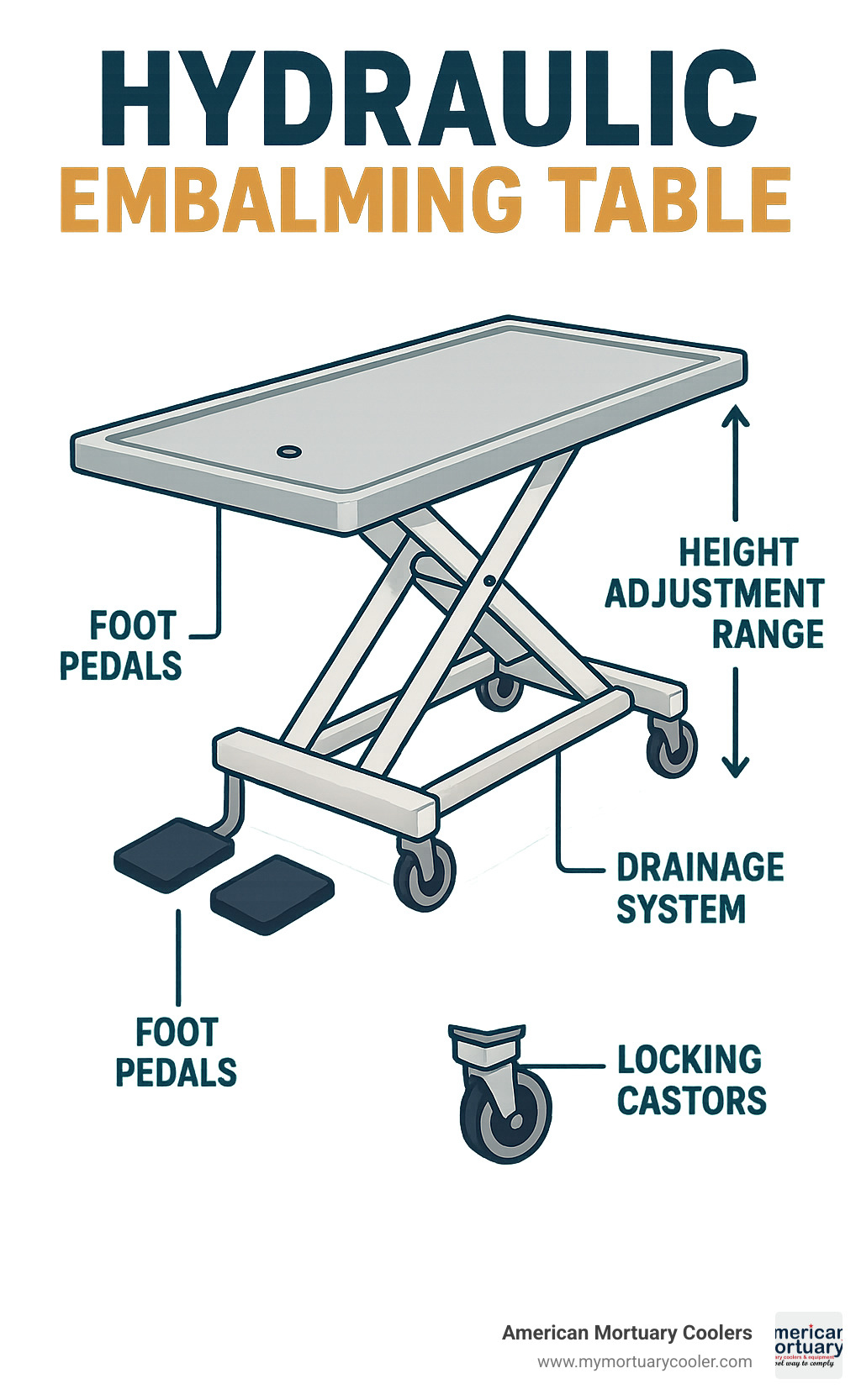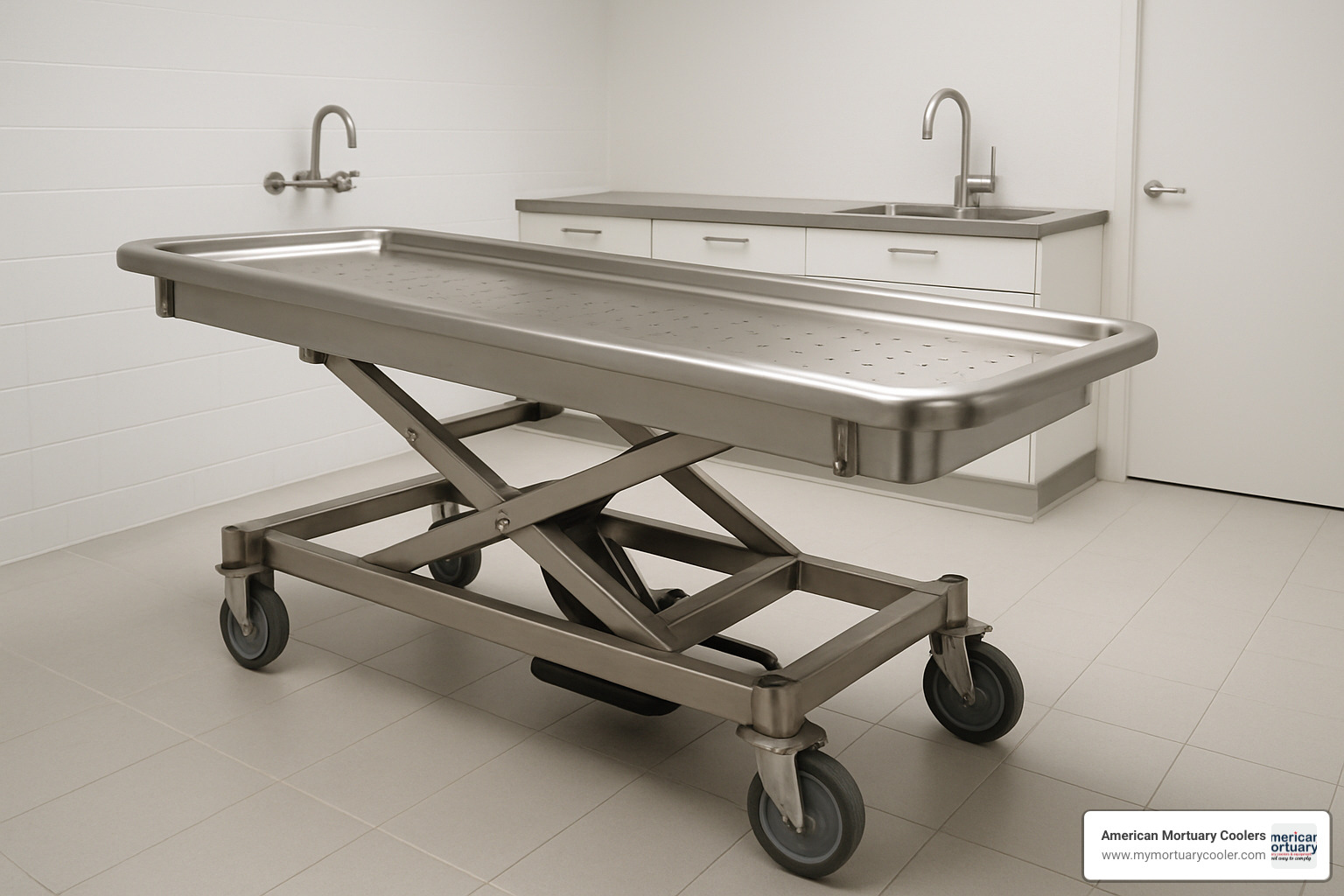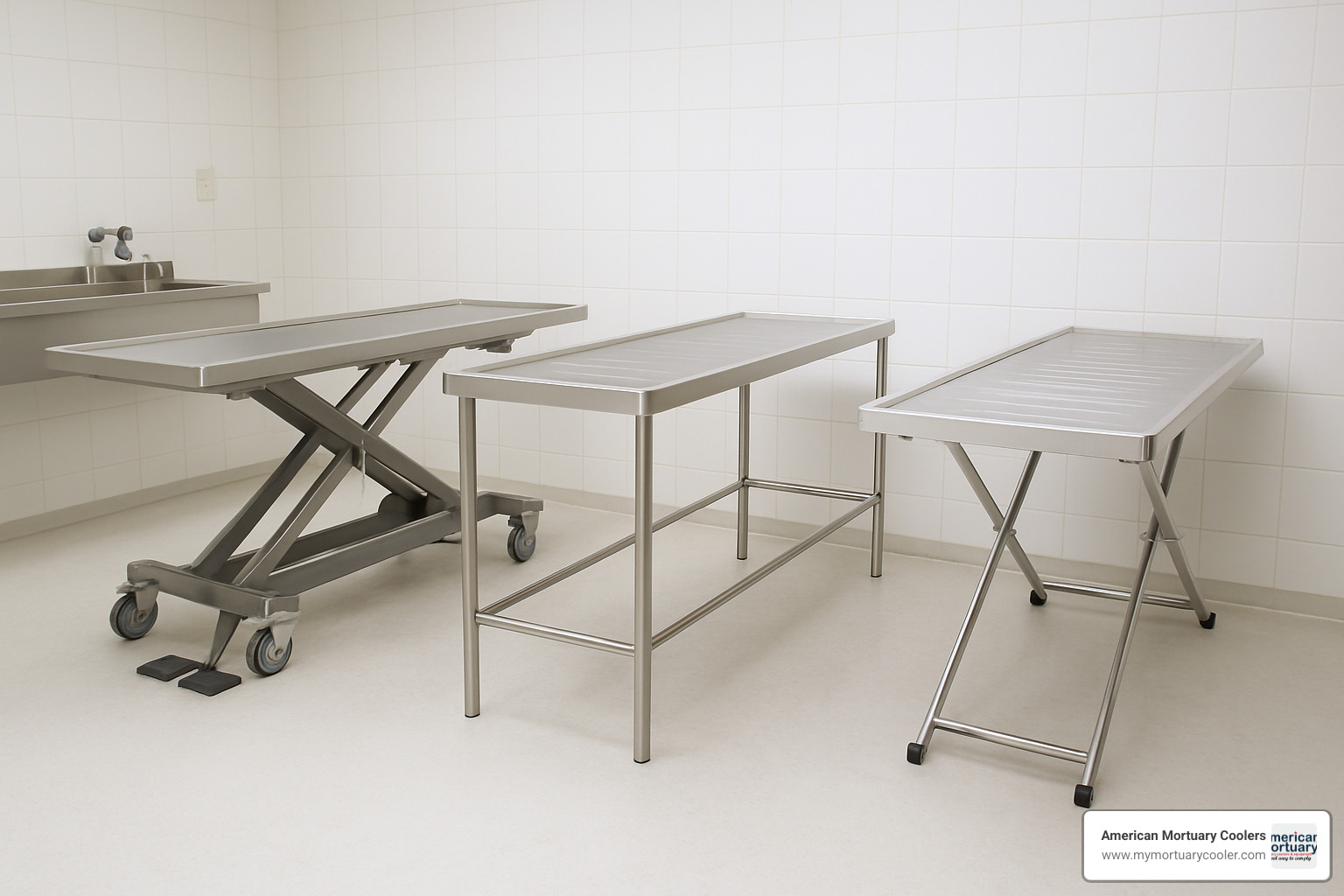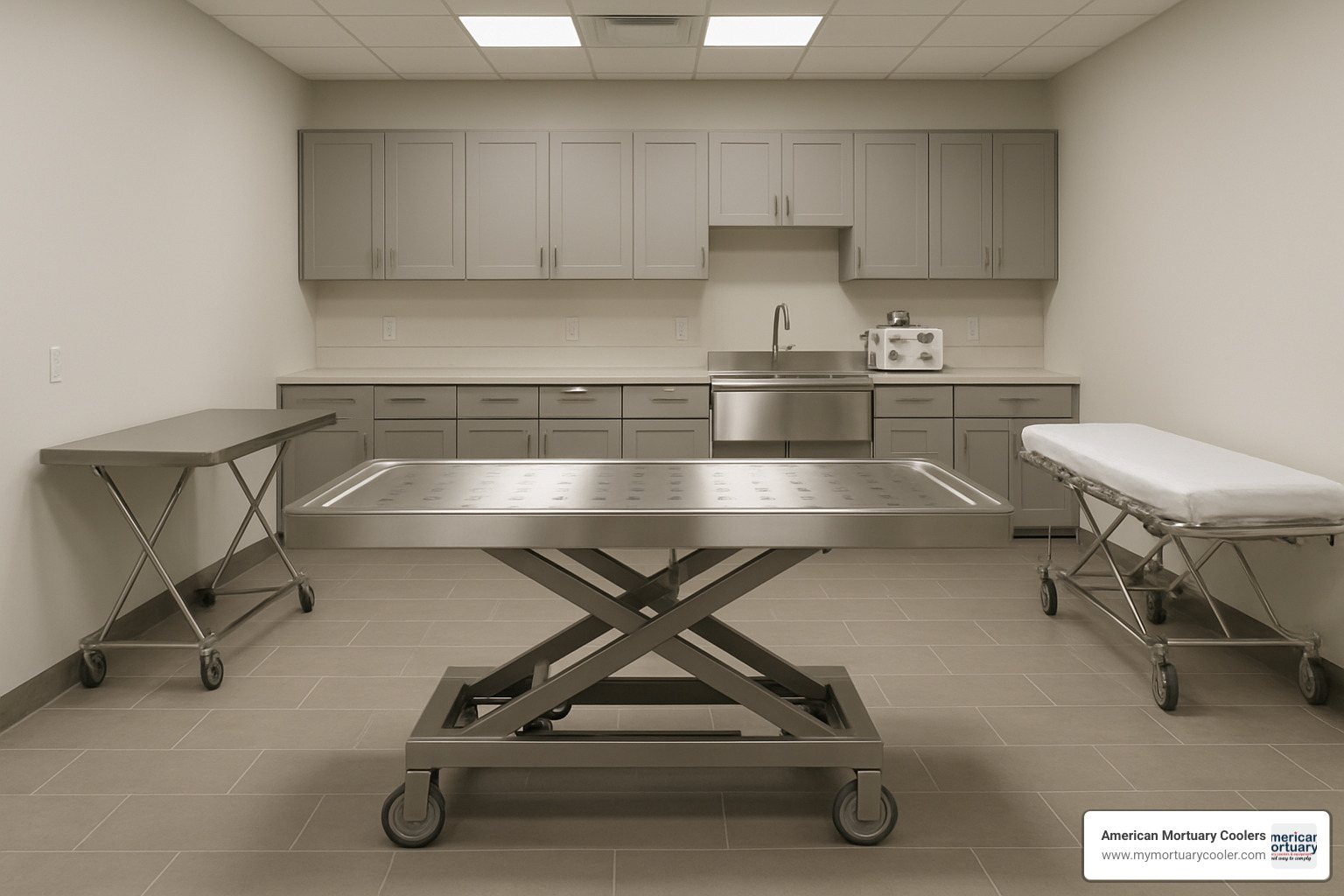The Foundation of Modern Prep Room Efficiency
A Hydraulic Embalming Table sits at the heart of every well-designed preparation room, revolutionizing how funeral professionals work. These specialized tables offer what fixed-height equipment simply can't—the ability to adjust to the perfect working height with just the tap of a foot pedal, saving your back while improving your focus on the important work at hand.
When you're spending hours performing meticulous preparation procedures, ergonomics isn't just a luxury—it's essential. The beauty of hydraulic tables lies in their versatility, typically adjusting from 27 to 40 inches to accommodate embalmers of different heights and various procedural needs.
Most modern Hydraulic Embalming Tables are crafted from durable 14-gauge 304 stainless steel, built to last through years of daily use. With standard dimensions of 83-85 inches in length and 32-35 inches in width, these tables provide ample workspace while fitting comfortably in most preparation rooms. The thoughtfully designed 3-inch deep trough channels fluids efficiently to the center drain, eliminating messy overflow and reducing cleanup time.
Weight capacity matters in today's funeral service environment. Standard models typically support up to 650 pounds, while bariatric options can accommodate up to 1,000 pounds—ensuring you're prepared for every situation without compromise.
I've seen how the right equipment transforms a preparation room's efficiency. At American Mortuary Coolers, we understand that investing in quality preparation equipment pays dividends in both staff well-being and procedural excellence. With prices typically ranging from $2,745 to $5,194, a Hydraulic Embalming Table represents a significant but worthwhile investment in your facility's capabilities.
The mobility factor shouldn't be overlooked either. Most hydraulic tables feature locking castors that allow you to reposition the table when needed, then secure it firmly in place during procedures—combining convenience with essential stability.

How Does a Hydraulic Embalming Table Operate?
The magic of a Hydraulic Embalming Table lies in its brilliantly simple yet powerful system that transforms a gentle press of your foot into enough lifting force to raise up to 1,000 pounds smoothly and effortlessly. It's this engineering that has revolutionized the way funeral professionals work. If you d like a deeper dive into the basic science behind these systems, the overview on hydraulic machinery is an excellent external resource.

When you walk into a modern prep room, you'll notice three foot pedals positioned at either the end or side of the table. Each has its specific job: one gently raises the table, another smoothly lowers it, and the third controls the Trendelenburg positioning (that's the slight tilt between 0-10 degrees that helps with fluid drainage during procedures).
With just a light tap on the raising pedal, hydraulic fluid rushes into cylinders that extend to lift the table from its lowest position (about 27 inches) up to its highest (around 40 inches). This 13-inch range is a game-changer for comfort, allowing professionals of all heights to work without hunching or straining.
"Before we upgraded to a hydraulic table, I was constantly adjusting my posture and straining my back," shared Mark Wilson, an Atlanta funeral director with 25 years in the profession. "Now, I can position the deceased at exactly the right height for whatever procedure I'm performing. It's been a game-changer for my physical wellbeing."
Those sturdy 6-8 inch locking castors aren't just for show, either. They provide smooth mobility when you need to reposition the table, then lock down firmly during procedures with a convenient center-locking brake system that secures all wheels simultaneously. You can find more specialized accessories at Embalming Supply Company - Prep Room Accessories to complement your setup.
Inside the Lift System
Peek beneath the surface of a Hydraulic Embalming Table, and you'll find a symphony of components working in perfect harmony.
At the core are robust hydraulic cylinders 2013 sealed units containing pistons that extend when hydraulic fluid flows in, providing the lifting power. Premium tables feature American-made Power-Packer actuators, renowned for their reliability and butter-smooth operation as they convert hydraulic pressure into precise linear motion.
A well-designed fluid reservoir holds specialized hydraulic fluid, while a network of valves and pumps controls the direction and pressure of this fluid. The beauty of hydraulics is in the physics: applying a small force to a small area (your foot on the pedal) creates pressure that's transmitted through fluid to a larger area (the lifting cylinders), multiplying your effort many times over.
Unlike their electric counterparts, hydraulic tables don't depend on power outlets or risk electrical issues 2013 making them more dependable in various settings. Many funeral professionals appreciate this reliability, especially in older facilities where electrical infrastructure might be limited. Both manual and electric options have their place, but the simplicity of hydraulics has stood the test of time.
Fluid Management in Action
Beyond lifting capabilities, a Hydraulic Embalming Table excels at managing the less glamorous but essential aspect of embalming 2013 fluid control.
Every quality table features a 3-inch deep trough that runs continuously around all four sides of the surface. This thoughtfully designed depth contains fluids without splashing or overflowing, even during procedures that generate significant volumes.
At the foot end sits a 6-inch drain stem 2013 the collection point for all fluids. Look closely and you'll notice the table surface has a subtle, almost imperceptible slope toward this drain. This clever engineering uses gravity to naturally channel fluids away from your work area, keeping both you and the floor drier.
"The genius of a well-designed hydraulic table's drainage system is in its simplicity," explains fluid management specialist David Chen. "By using gravity and proper slope engineering, fluids naturally flow where they should without pooling or splashing. This keeps the embalmer dry and the prep room cleaner."
This drainage design eliminates the need for cumbersome splash guards that can restrict access during procedures. No matter where fluids accumulate on the table, the continuous trough system efficiently guides them to the drain, maintaining a cleaner, more professional working environment.
Anatomy of a Hydraulic Embalming Table: Materials, Components & Safety Features
When you're looking at a Hydraulic Embalming Table, you're seeing a marvel of purposeful design. These tables aren't just functional—they're crafted to make your daily work safer, easier, and more efficient.

The heart of any quality table is its surface—typically made from 14-gauge 304 stainless steel. This isn't your kitchen-variety stainless; it's medical-grade material chosen specifically for its remarkable resistance to the harsh chemicals used in embalming. The chromium and nickel content in 304 stainless means you won't see those frustrating stains and pitting that lesser materials develop over time.
Most tables measure between 83-85 inches long and 32-35 inches wide—dimensions that provide generous working space while still fitting through standard doorway openings. Look closely and you'll notice a subtle convex curve to the surface that helps guide fluids toward the trough—a small detail that makes a big difference during busy procedures.
Beneath that gleaming surface lies a framework of heavy-gauge stainless steel tubing. This isn't just about supporting weight—though it certainly does that well—it's about creating a stable platform that won't wobble or shift during delicate procedures. The frame houses the hydraulic system while connecting to the base in a way that distributes weight evenly.
I've always appreciated how thoughtfully the safety features are integrated. The removable side rails prevent accidental falls without getting in your way. Those rounded marine edges eliminate sharp corners that could catch on clothing or cause injury. And have you noticed how there are no pinch points where the table raises and lowers? That's intentional design at work.
Jennifer Rodriguez, who teaches mortuary science, puts it perfectly: "What impresses me most about modern hydraulic tables is how thoughtfully designed they are. Every component serves multiple purposes—the stainless steel is both durable and easy to sanitize, while the trough system manages fluids and provides structural reinforcement."
Weight Capacities of a Hydraulic Embalming Table
Let's talk about something practical—how much weight can these tables actually handle?

Standard Hydraulic Embalming Tables typically support up to 650 pounds, which covers most situations you'll encounter. But our industry has evolved to recognize the need for more robust options. Today's bariatric-capable tables can safely support up to 1,000 pounds, giving you peace of mind no matter who comes through your doors.
These heavy-duty models aren't just standard tables with stronger legs. They're completely re-engineered with reinforced hydraulic cylinders, thicker gauge steel, and additional structural supports. Many feature wider surfaces—up to 35 inches across—providing both the strength and space needed for larger individuals.
It's worth noting a practical distinction: the weight capacity usually refers to what the table can safely hold when stationary, not necessarily what it can lift from its lowest position. Some manufacturers provide separate ratings for static support versus lifting capacity.
Industry trends show about 15% of funeral homes now maintain at least one bariatric-capable table. As Robert Johnson, who owns several funeral homes in Dallas, shared with me: "We invested in a 1,000-pound capacity hydraulic table three years ago, and it's proven invaluable. Not only does it provide the necessary support for larger individuals, but the extra width gives us more working space for all cases. The peace of mind knowing we can safely and respectfully accommodate any family is worth every penny."
Built-In Safety & Ergonomics
The best Hydraulic Embalming Tables protect both you and the deceased through thoughtful safety features that might not be obvious at first glance.
Take the anti-pinch design, for example. Notice how all the moving parts have protective covers and maintain safe clearances? That's not by accident. These tables are engineered to eliminate places where fingers or clothing could get caught during height adjustments—a small detail that prevents painful accidents during busy days.
The center-lock braking system is another feature I particularly appreciate. With just one foot movement, you can secure all wheels simultaneously. It's so much more practical than having to lock each caster individually, especially when you need to quickly stabilize the table.
Those rounded corners and marine edges aren't just about looks—they serve multiple practical purposes. They prevent painful bumps when you're moving around the table, protect your walls during transport, create a seamless surface that's easier to sanitize, and help contain fluids within the trough system. Form and function in perfect harmony.
Even the foot pedals show careful consideration of human factors. They're positioned for natural foot placement and require minimal pressure to activate. After a long day of standing, the last thing you need is to struggle with stiff pedals.
The height range of 27-40 inches is specifically designed to accommodate staff members from the 5th percentile female to the 95th percentile male, meaning virtually everyone on your team can work at their optimal height.
Lisa Chen, an occupational therapist who specializes in workplace ergonomics, put it beautifully: "The beauty of hydraulic embalming tables from an ergonomic perspective is how they adapt to the worker rather than forcing the worker to adapt to them. By eliminating awkward postures and reducing repetitive strain, they significantly decrease the risk of musculoskeletal disorders common in the funeral profession."
Why Choose a Hydraulic Embalming Table Over Standard or Folding Options?
When it's time to equip your preparation room, you're faced with an important choice: fixed-height, folding, or hydraulic embalming tables. Each option has its own strengths and limitations that will directly impact your daily operations—and potentially your staff's wellbeing.

Let's be honest—preparation work is physically demanding. That's where a hydraulic embalming table truly shines. With height adjustability from 27-40 inches, these tables allow your team to position the deceased at the perfect working height, reducing back strain by up to 40% compared to fixed-height surfaces. Your shorter and taller staff members will thank you equally!
The deep 3-inch trough systems in hydraulic tables efficiently channel fluids away from your work area, creating a cleaner, safer environment. Standard tables often have shallower troughs or require additional splash guards that can get in your way during procedures.
For those increasingly common bariatric cases, hydraulic embalming tables offer superior weight capacities (650-1,000 lbs) and stability that simply can't be matched by folding models. As Michael Torres, a funeral director from Chicago, told us: "We initially hesitated at the higher price point of hydraulic tables, but after calculating the reduced strain on our staff, decreased cleaning time, and improved workflow efficiency, the decision became obvious. Within a year, the ergonomic benefits alone justified the investment."
The mobility factor is another game-changer. Quality hydraulic tables feature robust 6-8" castors that allow a single person to easily move the table throughout your preparation area. No more calling for backup just to reposition a table!
| Feature | Hydraulic Table | Standard Fixed Table | Folding Table |
|---|---|---|---|
| Height Adjustment | 27-40 inches | Fixed (typically 34") | Limited/Manual |
| Weight Capacity | 650-1,000 lbs | 400-600 lbs | 300-600 lbs |
| Ergonomics | Excellent | Poor | Moderate |
| Fluid Management | 3" trough system | Varies | Minimal |
| Mobility | 6-8" locking castors | Fixed or basic castors | Highly portable |
| Space Efficiency | Moderate | Poor | Excellent |
| Price Range | $2,745-$5,194 | $1,500-$3,000 | $1,200-$2,800 |
| Durability | 10+ years | 7-10 years | 5-7 years |
Yes, folding tables win the space-saving contest—particularly valuable if you're working with limited square footage. But that advantage comes with significant trade-offs in stability, fluid management, and ergonomics that you'll feel every single day.
For more detailed comparisons, you might find our guide on Lift Your Practice: Best Hydraulic Embalming Tables helpful in making your decision.
Cost-Benefit Snapshot
I know what you're thinking—hydraulic tables cost more upfront. But let's talk about the real return on your investment:
Staff Health and Retention
Your team is your greatest asset. Reduced physical strain means fewer sick days and lower turnover rates. Preparation rooms with ergonomic equipment experience 25-30% lower staff turnover compared to those with basic equipment. That alone can offset the price difference!
Operational Efficiency
The ability to quickly adjust table height and position streamlines your embalming process. Facilities typically report 15-20% time savings per case after switching to hydraulic embalming tables. That adds up quickly when you're handling multiple cases per week.
Maintenance and Longevity
Quality hydraulic tables typically offer 10+ years of reliable service with minimal maintenance, compared to 5-7 years for folding tables. When you spread that investment over a decade of daily use, the annual cost difference becomes much more reasonable.
Risk Mitigation
The improved stability and safety features reduce the risk of workplace accidents and associated liability. As Sarah Williams, a funeral home financial consultant, puts it: "When analyzing equipment ROI, we look beyond the sticker price to consider total cost of ownership. Hydraulic tables consistently deliver superior value when factoring in durability, reduced cleaning time, improved staff wellbeing, and improved procedural efficiency."
One dropped case can cost far more than the price difference between table types—both financially and in terms of your reputation. Some things are simply worth investing in from the start.
Selecting, Maintaining & Accessorizing Your Table
Let's talk about finding your perfect prep room partner. Choosing a Hydraulic Embalming Table isn't just about picking equipment—it's about investing in your team's wellbeing and your facility's future.
When I help funeral homes select their tables, I always start with a simple question: "How does your team actually work?" Because the best table is one that fits your specific needs, not just your budget.
First, grab that measuring tape. Your prep room needs adequate clearance (at least 30 inches) around all sides of the table. Unlike their folding cousins, hydraulic tables need a permanent home—they're not exactly closet-friendly!
Consider who'll be using the table daily. If your team includes both 5'2" and 6'4" embalmers, you'll appreciate a model with the full 27-40" height range. Your staff's backs will thank you.
Price tags typically run between $2,745 and $5,194, but think of it as a decade-long investment. When you break it down, that's about $275-$520 annually—less than many of us spend on coffee each year! And the returns on staff health and efficiency are substantial.
Thomas Garcia, a third-generation funeral director from Pittsburgh, shared this wisdom with me: "Don't just compare prices—compare features that matter for your specific operation. We serve a community with a high percentage of larger individuals, so investing in a wider table with higher weight capacity was essential for us, even though it wasn't the lowest-priced option."
When reviewing warranties, look beyond the basics. Quality manufacturers stand behind their products with 1-3 years of coverage for hydraulic components and 3-5 years for structural elements. This confidence speaks volumes about durability.
Maintaining Your Investment
Think of your Hydraulic Embalming Table maintenance like caring for a quality vehicle—regular attention prevents costly breakdowns.
Your daily cleaning routine should include wiping down all surfaces with approved disinfectants, paying special attention to the trough and drain areas where residue loves to hide. Five minutes at day's end keeps everything sanitary and functioning properly.
Weekly, take a moment to check those castors for debris (they collect everything from hair to tissue paper), test the brake mechanisms, and visually inspect hydraulic connections for any signs of leakage. These quick checks prevent most common issues.
Quarterly maintenance doesn't need to be complicated—just lubricate moving parts according to your manufacturer's specs and run the table through its full range of motion. Think of it as giving your table a little exercise!
Most hydraulic systems benefit from professional inspection annually, including fluid level checks and seal integrity assessment. And while it might seem excessive, replacing hydraulic fluid every 3-5 years prevents costly system failures. Trust me—a $150 fluid change beats a $1,500 repair bill any day.
Accessories That Maximize Your Hydraulic Embalming Table
The right accessories can transform a good Hydraulic Embalming Table into a great one, customized perfectly for your workflow.
Removable handles are perhaps the most underrated add-ons in the prep room. They attach via quick-release mechanisms to help safely transport the deceased, then disappear when you need unobstructed access during procedures. They're rated to support about 150 pounds of lateral force—perfect for guiding the table through doorways.
If your drain placement isn't ideal (and let's be honest, in many older buildings, it rarely is), drainage accessories become essential:
- Extended drain hoses direct waste to distant floor drains
- Inline filters catch tissue and prevent plumbing nightmares
- Drainage pumps provide assistance in facilities where gravity alone isn't cutting it
Body positioning aids make a tremendous difference in procedure efficiency. Adjustable headrests provide proper neck extension without awkward towel arrangements. Body blocks keep everything properly aligned, and arm supports eliminate the need for temporary suturing to position limbs.
Maria Sanchez, a preparation room specialist I met at a conference in Los Angeles, told me: "We've found that investing in quality accessories actually saves money long-term. Our adjustable headrest system has virtually eliminated the need for head blocks, while our extended drainage system has reduced cleanup time by nearly 30%."
For those occasional larger cases, oversize extensions can temporarily add 6-12 inches to your table width. This gives you the versatility to handle bariatric cases without committing to a permanently oversized table that might overwhelm your space.
One last tip: whenever possible, choose accessories specifically designed for your table model. Universal add-ons often require modifications that can void warranties or compromise performance. Your table manufacturer likely offers compatible options that integrate seamlessly.
Frequently Asked Questions about Hydraulic Embalming Tables
Q: How much weight can a hydraulic embalming table safely support?
A: Standard Hydraulic Embalming Tables typically support 650 pounds, while bariatric models accommodate up to 1,000 pounds. Static weight capacity (when stationary) may differ slightly from dynamic lifting capacity (what it can raise from its lowest position).
Q: How often does a hydraulic embalming table require maintenance?
A: Beyond daily cleaning, follow this simple schedule: monthly visual inspections of hydraulic components, quarterly testing of motion range and lubricating moving parts, annual professional inspection of seals and fluid systems, and hydraulic fluid replacement every 3-5 years depending on usage.
Q: When should I choose an oversized hydraulic embalming table model?
A: Consider going bigger if your facility regularly handles individuals exceeding 350 pounds, your embalmers prefer additional workspace, you frequently perform complex restorative procedures requiring extra surface area, or if your prep room has adequate space for the larger footprint.
Q: Can hydraulic tables be used for purposes beyond embalming?
A: Absolutely! Many facilities use their Hydraulic Embalming Tables for dressing and casketing, temporary holding during busy periods, restorative art procedures, appropriate family identifications, and even staff training demonstrations. Their versatility makes them valuable beyond their primary purpose.
Q: What's the typical lifespan of a hydraulic embalming table?
A: With proper care, quality tables typically deliver 10-15 years of reliable service. The stainless steel components often last indefinitely, while hydraulic systems may need component replacement after 8-10 years of regular use.
Q: Are there special cleaning considerations for hydraulic tables?
A: Yes—while stainless steel surfaces resist most chemicals, avoid abrasive cleaners that can scratch the finish, bleach concentrations beyond manufacturer recommendations, fluid pooling around hydraulic seals, and pressure washing (which forces moisture into sensitive components). Always follow your manufacturer's specific cleaning guidelines.
Conclusion
The hydraulic embalming table represents far more than just another piece of equipment—it's a genuine investment in excellence that touches every aspect of your preparation room operations. Throughout this guide, we've explored how these remarkable tables deliver real, everyday benefits through thoughtful design choices that put people first.
When you look at everything we've covered—from the smoothly operating hydraulic systems that protect your staff's backs to the cleverly designed drainage features that keep your prep room cleaner—it's clear why so many funeral professionals consider these tables essential. The comparison with standard fixed tables and folding alternatives shows why hydraulic models make so much sense, especially when you think about the long-term impact on your team's wellbeing and efficiency.
I've spoken with countless funeral directors who tell me the same story: "I wish we'd upgraded years earlier." That's because the benefits become apparent immediately, from the first procedure where a shorter embalmer can raise the table to their perfect working height, to the first bariatric case where the table's sturdy construction provides complete confidence.
At American Mortuary Coolers, we understand that every preparation room has its own unique challenges and requirements. While our specialty is custom mortuary cooling systems, we know that quality preparation equipment forms the foundation of exceptional care. Our team—from New York to Los Angeles, Chicago to Dallas—is always available to chat about how the right equipment combination can transform your daily operations.
Whether you're setting up a brand-new facility or upgrading equipment that's seen better days, choosing a hydraulic embalming table shows your commitment to doing things right. This investment doesn't just improve your technical capabilities—it sends a clear message to your staff and the families you serve that excellence matters at every stage of your process.
For more information about complementary preparation room equipment, including our custom cooling solutions, take a look at our resources on embalming tables, folding dressing tables, mortuary cots, and church trucks or reach out to our team to discuss what might work best for your specific situation.

Your preparation room is truly the heart of your technical operation—it deserves to be equipped with tools that make your team's work easier, safer, and more efficient every single day.


















